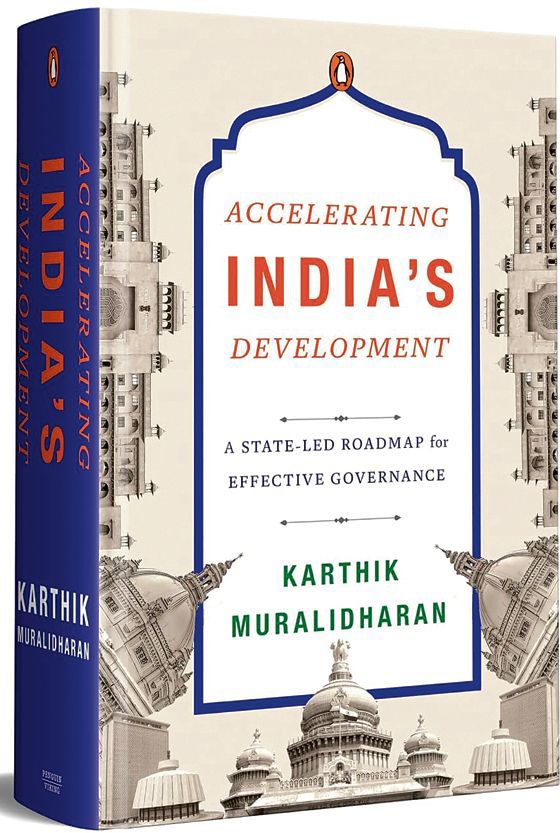Accelerating India’s Development: A State-led Roadmap for Effective Governance. by Karthik Muralidharan. Penguin Viking. Pages 812. Rs 1,299
Book Title:
Aunindyo Chakravarty
Karthik Muralidharan has an impressive CV. He studied at Harvard and Cambridge, and is a professor of economics at the University of California, San Diego. What makes him different is the experience he has gathered by collaborating with governments in working out more efficient systems for delivering welfare to citizens. And, that is what his book, ‘Accelerating India’s Development’, is mostly about — how to reimagine the Indian state to make it more effective in the lives of its people.
Muralidharan’s prescription is very different from what one would expect from an economist trained at leading global universities. Instead of arguing for less government, he makes a case for a bigger government for better governance. The author’s key thesis is that, in the long run, the private sector cannot deliver welfare goods and services for all citizens, especially in countries like ours where the poor cannot afford to pay for private services. What is required, instead, is sustained targeted spending by a state which has effective capacity.
The author argues that India has not invested in building state capacity since the 1950s. Today, India has one of the lowest ratios of public servants in the world: 16 public employees serving every 1,000 citizens, whereas even the US, the home of laissez-faire economics, has 77 for every 1,000 people. Perhaps, this is one reason why India’s public spending is so heavily centralised, with just 3 per cent of the budget going to local bodies of government. Compare that to China, which despite its centralised autocratic polity, allocates 51 per cent of expenditure to local governments. This, according to the author, is a double weakness for India’s welfare spending, since decisions are taken at the top, and there are not enough people to implement them.
Muralidharan cites several studies, including those done by him, to show that the Return on Investment (RoI) on public servants in closely-monitored government projects is more than 10 times what is spent on them. This is especially true given that biometrics, big data, and even AI, can greatly improve not just delivery, but also monitoring and supervision, to minimise leakages and corruption in public welfare schemes. He gives the example of Telangana, where spending on a call centre to monitor the distribution of Rythu Bandhu funds improved disbursals. Each rupee spent on the call centre resulted in an additional 25 rupees being delivered to farmers.
The author gives several practical suggestions on how to increase the number of public employees, without creating an unwieldy permanent bureaucracy. One proposal is to employ suitable candidates, on renewable fixed-term contracts, from an ‘empanelled’ staff of the top 1-2 per cent of UPSC aspirants. This will significantly increase the number of government employees who can assist administrators on the ground, without giving them unconditional permanent jobs. The added benefit would be that all the candidates would have gone through the rigorous UPSC selection process. This would also replace the current practice of hiring private sector consultants to speed up government projects. That is often more expensive and taps people with lesser interest in public service.
The obvious question is — where will the money come from? Despite Muralidharan’s assertion that the RoI on public spending is extremely high, and that efficient public spending can make each rupee go a long way, increasing state expenditure will require significant funds. This is where this reader found the author’s arguments and proposals the least persuasive, in a book that is otherwise rich in pragmatic solutions. He backs the Lafferian idea that lower tax rates on a wider tax base increase tax revenues through higher compliance. This has been questioned convincingly by other economists. Similarly, his support for a single GST rate is demonstrably regressive in a country where consumption varies drastically as we climb up the income ladder. Even the idea of taxing agriculture above a certain limit has been shown to have very little impact on aggregate tax revenues, given the very small proportion of farmers who fall in the taxable category.
Muralidharan’s argument that these tax proposals might be regressive, but the “overall system is progressive” is not entirely convincing. This weakness does not take away from the overall validity of his case for state-led development spending. One could argue that his proposals can be funded through a temporary period of higher fiscal deficits. That would be no different from a firm borrowing to invest in a business and paying off the loan from the greater earning. This would not violate the author’s core thesis that it is not public spending that matters, but how and what it is spent on.
There have been many scholarly works on analysing why India has not been able to deliver on its promise of development for all. Where Muralidharan’s book stands out is that it is not just a diagnosis of the problems, but is a data-backed, pragmatic guide on how to solve them. The book is an extremely easy read, but its intimidating size might deter potential readers from committing to it.














